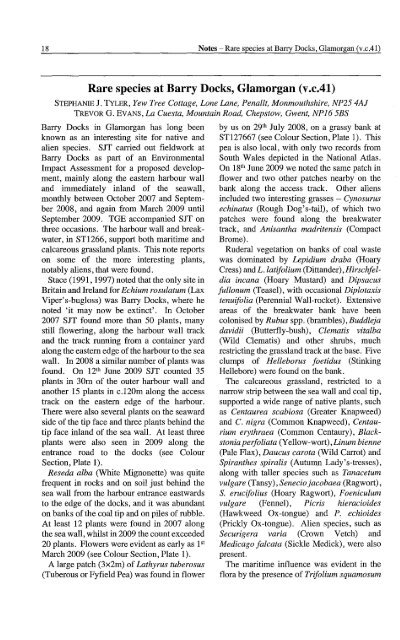BSBINews - BSBI Archive - Botanical Society of the British Isles
BSBINews - BSBI Archive - Botanical Society of the British Isles
BSBINews - BSBI Archive - Botanical Society of the British Isles
You also want an ePaper? Increase the reach of your titles
YUMPU automatically turns print PDFs into web optimized ePapers that Google loves.
18 Notes - Rare species at Barry Docks, Glamorgan (v.c.4l)<br />
Rare species at Barry Docks, Glamorgan (voc.4l)<br />
STEPHANIE J. TYLER, Yew Tree Cottage, Lone Lane, Penallt, Monmouthshire, NP254AJ<br />
TREVOR G. EVANS, La Cuesta, Mountain Road, Chepstow, Gwent, NP16 5BS<br />
Barry Docks in Glamorgan has long been by us on 29 th July 2008, on a grassy bank at<br />
known as an interesting site for native and ST127667 (see Colour Section, Plate 1). This<br />
alien species. SJT carried out fieldwork at pea is also local, with only two records from<br />
Barry Docks as part <strong>of</strong> an Environmental South Wales depicted in <strong>the</strong> National Atlas.<br />
Impact Assessment for a proposed develop- On 18 th June 2009 we noted <strong>the</strong> same patch in<br />
ment, mainly along <strong>the</strong> eastern harbour wall flower and two o<strong>the</strong>r patches nearby on <strong>the</strong><br />
and immediately inland <strong>of</strong> <strong>the</strong> seawall, bank along <strong>the</strong> access track. O<strong>the</strong>r aliens<br />
monthly between October 2007 and Septem- included two interesting grasses - Cynosurus<br />
ber 2008, and again from March 2009 until echinatus (Rough Dog's-tail), <strong>of</strong> which two<br />
September 2009. TGE accompanied SJT on patches were found along <strong>the</strong> breakwater<br />
three occasions. The harbour wall and break- track, and Anisantha madritensis (Compact<br />
water, in ST1266, support both maritime and Brome).<br />
calcareous grassland plants. This note reports Ruderal vegetation on banks <strong>of</strong> coal waste<br />
on some <strong>of</strong> <strong>the</strong> more interesting plants, was dominated by Lepidium draba (Hoary<br />
notably aliens, that were found. Cress) and L.latifolium (Dittander),Hirschfel-<br />
Stace (1991, 1997) noted that <strong>the</strong> only site in dia incana (Hoary Mustard) and Dipsacus<br />
Britain and Ireland for Echium rosulatum (Lax fullonum (Teasel), with occasional Diplotaxis<br />
Viper's-bugloss) was Barry Docks, where he tenuifolia (Perennial Wall-rocket). Extensive<br />
noted 'it may now be extinct'. In October areas <strong>of</strong> <strong>the</strong> breakwater bank have been<br />
2007 SJT found more than 50 plants, many colonised by Rubus spp. (brambles),Buddleja<br />
still flowering, along <strong>the</strong> harbour wall track davidii (Butterfly-bush), Clematis vitalba<br />
and <strong>the</strong> track running from a container yard (Wild Clematis) and o<strong>the</strong>r shrubs, much<br />
along <strong>the</strong> eastern edge <strong>of</strong> <strong>the</strong> harbour to <strong>the</strong> sea restricting <strong>the</strong> grassland track at <strong>the</strong> base. Five<br />
wall. In 2008 a similar number <strong>of</strong> plants was clumps <strong>of</strong> Helleborus foetidus (Stinking<br />
found. On 12th June 2009 SJT counted 35 Hellebore) were found on <strong>the</strong> bank.<br />
plants in 30m <strong>of</strong> <strong>the</strong> outer harbour wall and The calcareous grassland, restricted to a<br />
ano<strong>the</strong>r 15 plants in c.l20m along <strong>the</strong> access narrow strip between <strong>the</strong> sea wall and coal tip,<br />
track on <strong>the</strong> eastern edge <strong>of</strong> <strong>the</strong> harbour. supported a wide range <strong>of</strong> native plants, such<br />
There were also several plants on <strong>the</strong> seaward as Centaurea scabiosa (Greater Knapweed)<br />
side <strong>of</strong> <strong>the</strong> tip face and three plants behind <strong>the</strong> and C. nigra (Common Knapweed), Centautip<br />
face inland <strong>of</strong> <strong>the</strong> sea wall. At least three rium erythraea (Common Centaury), Blackplants<br />
were also seen in 2009 along <strong>the</strong> stoniaperfoliata(Yellow-wort),Linumbienne<br />
entrance road to <strong>the</strong> docks (see Colour (Pale Flax), Daucus carota (Wild Carrot) and<br />
Section, Plate 1). Spiran<strong>the</strong>s spiralis (Autumn Lady's-tresses),<br />
Reseda alba (White Mignonette) was quite along with taller species such as Tanacetum<br />
frequent in rocks and on soil just behind <strong>the</strong> vulgare (Tansy), Senecio jacobaea (Ragwort),<br />
sea wall from <strong>the</strong> harbour entrance eastwards S. erucifolius (Hoary Ragwort), Foeniculum<br />
to <strong>the</strong> edge <strong>of</strong> <strong>the</strong> docks, and it was abundant vulgare (Fennel), Picris hieracioides<br />
on banks <strong>of</strong> <strong>the</strong> coal tip and on piles <strong>of</strong> rubble. (Hawkweed Ox-tongue) and P. echioides<br />
At least 12 plants were found in 2007 along (Prickly Ox-tongue). Alien species, such as<br />
<strong>the</strong> sea wall, whilst in 2009 <strong>the</strong> count exceeded Securigera varia (Crown Vetch) and<br />
20 plants. Flowers were evident as early as 1 st Medicago falcata (Sickle Medick), were also<br />
March 2009 (see Colour Section, Plate 1). present.<br />
A large patch (3x2m) <strong>of</strong> Lathyrus tuberosus The maritime influence was evident in <strong>the</strong><br />
(Tuberous or Fyfield Pea) was found in flower flora by <strong>the</strong> presence <strong>of</strong> Trifolium squamosum

















